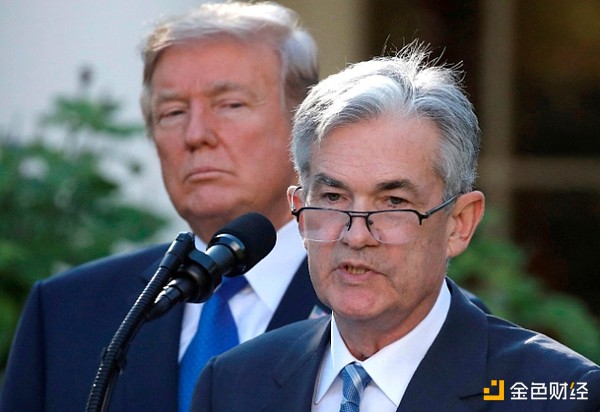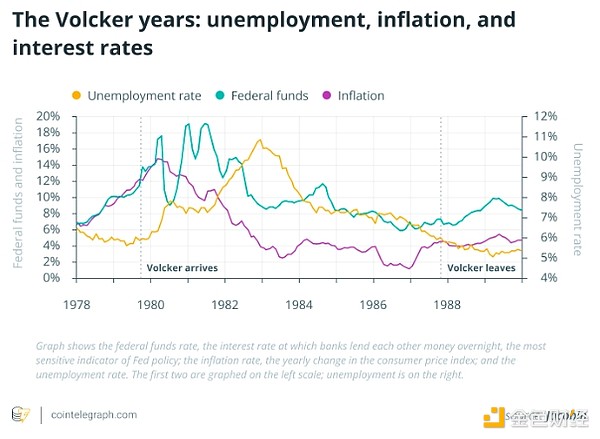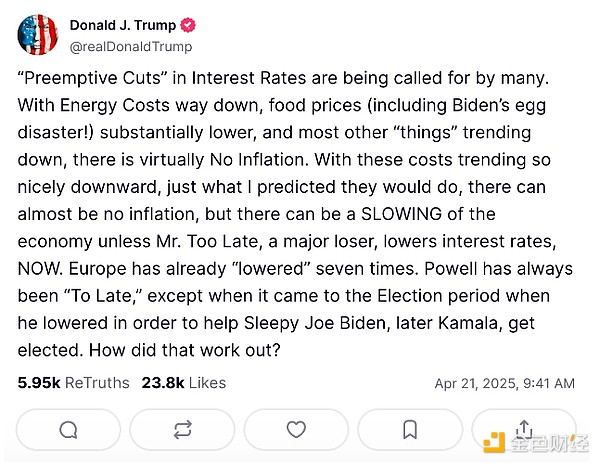Author: Aaron Brogan, CoinTelegraph; Translated by: Tao Zhu, Jinse Finance
In recent months, a pattern has emerged: US President Donald Trump would take actions objectively harmful to the US economy, and the market would crash. Seeing this, Trump would turn to Federal Reserve Chairman Jerome Powell, demanding he lower the federal funds rate - the rate at which the Fed lends to banks. Powell would look steadfast and say, "No."
Trump wanted to lower rates because this would effectively inject cash into the US economy, stimulate economic activity, and boost the market. He believed this would make him appear successful. Powell wanted to follow strict economic standards in setting rates to carefully balance the Fed's dual mission of maximizing employment and maintaining price stability.
He also wanted to maintain the Fed's independence from political pressure, and critically, preserve the Fed's independence from political pressure. If the market believed the US central bank's independence had been compromised, selling US Treasury bonds (US sovereign debt) could become more difficult. Fundamentally, this is a problem because the US would have to pay more to borrow money, thereby making itself poorer - but now this issue is especially severe, as the US is already carrying $30 trillion in massive debt that must be regularly refinanced.
If forced to refinance at higher rates due to the market no longer trusting the US government, interest costs would absorb a larger proportion of GDP, and as kids would say, the US would be totally destroyed.
Last week, Trump repeatedly hinted he wanted to fire Powell, and the market was not pleased. On Monday, Trump called Powell a "big failure" on his "Truth Social" platform, causing a stir. Reportedly, in response, Treasury Secretary Scott Bessent expressed concerns to Trump about the risks of firing Powell, and Trump currently seems to have tacitly approved this approach, stating on Tuesday that he would not fire the Fed chairman.

Trump and Powell in 2017. Source: Loyalty
Nevertheless, the process feels more like a spiral, with many market observers waiting for the next event to occur. This raises the question: What would happen if Trump truly acts on his instinct and fires Powell? Specifically, what impact would this have on the cryptocurrency industry?
Cracking the Federal Reserve
It's worth noting that the president should not be able to arbitrarily fire the Fed chairman. Section 10 of the 1913 Federal Reserve Act states that "each member's term is fourteen years after the expiration of their predecessor's term, unless the president removes them for cause."
This wording might seem ambiguous, but in the 1935 "Humphrey's Executor v. United States" case, the Supreme Court ruled that the Constitution does not grant the president "unlimited removal power", thus the president's removal power is limited by statutory language.
The decision approved the concept of "independent agencies", which are part of the executive branch but possess independent powers. While many institutions have this characteristic, including the US Securities and Exchange Commission, Commodity Futures Trading Commission, and Federal Trade Commission, the Federal Reserve is the most important.
Economists are not too concerned about central bank political control. Politicians' motivations are relatively short-term, thinking in years or election cycles. This essentially drives them toward short-term policies, with hot money injection being the purest form. However, fiscal and monetary policies are subtle arts that often involve painful policy choices.
A typical example is Richard Nixon pressuring then-Fed Chairman Arthur Burns to pursue expansionary monetary policy before the 1972 election, believing this would help improve his re-election chances. Nixon won that election overwhelmingly, but shortly after, a disastrous "stagflation" occurred, plunging the US economy into a decade-long paralysis, with industries gutted during that period still feeling the impact today.
In stark contrast was Paul Volcker's policy, who implemented a series of aggressive rate hikes from 1979 to 1987 after the disastrous stagflation period, causing the "Volcker Shock" - a series of painful economic recessions. However, this policy ultimately suppressed inflation and foreshadowed the economic prosperity of the 90s, contributing to Bill Clinton's excellent fiscal policy.

No politician could or will make such a choice, and therein lies the problem. Economists - and critically, the markets - firmly believe the Fed must remain independent, or the entire economic structure of American society could collapse. This is no exaggeration - countries with politically controlled central banks like Weimar Republic Germany, Peronist Argentina, and Venezuela have experienced extremely severe hyperinflation, causing geopolitical regression across generations, with people starving, eating rats, and even leading to Adolf Hitler's rise. This is a serious matter.
To fire Powell, Trump must first overturn the Humphrey's Executor precedent, and given the current Supreme Court composition, many legal scholars believe this is quite possible. This is a Rubicon that, once crossed, cannot be turned back. Not just for Trump, but for every subsequent president who would then have complete legal power to command all executive officials - including the Fed chairman. Most believe this would lead to destruction.
But whether a disaster occurs or not, this will be a test for cryptocurrency. The original Bitcoin white paper aimed to separate financial transactions from "financial institutions as trusted third parties". If the Fed falls and US monetary policy deviates from rational judgment, cryptocurrency's early arguments will become very apparent.
Due to Trump's recent capital flight, investors have been seeking safety in various assets. Traditionally, when a crisis occurs, savvy investors move risk assets into US Treasuries. People considered these risk-free assets. Well, those days might be over. During the tariff crisis peak, 10-year bond yields approached 5%, and have not yet fully returned to previous low points. If Trump undermines the Fed, these capital outflows would be just a drop in the ocean, potentially flowing into cryptocurrencies.

Trump warns Powell, here called "Mr. Too Late".
Historically, Bitcoin's price has closely tracked Nasdaq (with a multiplier). However, since the tariff crisis, despite US securities prices remaining largely stagnant, Bitcoin has miraculously begun to rise. This has led some to speculate that we are witnessing the long-predicted "decoupling", where crypto assets will achieve their original purpose and become independent of centralized assets.
We cannot assert whether this will happen, but if Trump fires Powell, we will certainly know.
From the Frying Pan into the Fire
Of course, the world's historic collapse is not entirely good for cryptocurrencies, and this crisis will bring enormous pain in various aspects. First, stablecoins will almost immediately feel terrible consequences.
Over the past decade, two dollar-denominated stablecoins—USDC and Tether's USDT—have dominated the market. Their issuers, Circle and Tether, are important systemic institutions and major buyers of U.S. Treasury bonds, with most of their stablecoin debt collateralized by U.S. Treasury bonds.
The direct consequence of the Federal Reserve crisis could be Treasury default. Economist Noah Smith speculated that Trump might attempt to write down U.S. sovereign debt:
"I suspect Trump will do something more similar to what he did as a businessman with debt issues—seek cheap relief, and if not, declare bankruptcy."
In fact, the president himself has hinted at such a prospect, stating in February this year that they might take measures to reduce banknote prices:
"There might be an issue—you've certainly read articles about U.S. debt, which could be an interesting matter. [...] Many things might not count at all. In other words, some things we discover are very fraudulent, so our debt might be less than we imagine."
Sovereign default would immediately impact Circle and Tether, causing their collateral value to decline. This could, in turn, lead to stablecoin under-collateralization, triggering a bank run. The market might eventually stabilize, but events could easily reverse, potentially causing major stablecoin collapse.
This would produce many second-order effects, as smart contract collaterals would begin liquidating positions and spreading across the entire market.
Interestingly, these consequences might not be as terrible as the Federal Reserve crisis's political costs, because Treasury bonds are not the only systemically important asset for cryptocurrencies. The U.S. dollar has long been the world's reserve currency. There are many good reasons for this: it's relatively strong and stable, making it suitable for trade. However, if the government supporting it is no longer strong and stable, this pattern might change.
As more transactions occur in accounts denominated in euros or renminbi, EU and Chinese regulators will have more control over legal currency flows through cryptocurrencies. A prominent crypto lawyer, who chose anonymity due to fear of political retaliation, speculated on this:
I believe China will fill most of the gap, and the EU will fill the remaining portion. China and the EU will over-regulate in different ways for different objectives, which is generally unfavorable for the crypto industry. This seems quite bad.
This might encourage people to turn to uncolateralized crypto native assets, but essentially no precedent suggests such assets are used extensively in real-world transactions. The stablecoin crisis will likely deal a severe blow to the industry in the coming years, just as it was getting on track.
Ultimately, no one knows whether Trump will fire Powell, or if he can even do so. No one knows what consequences his decisions might bring. But if a butterfly flapping its wings in Argentina can cause a tornado in Prague, then Donald Trump's musings in the White House might forever prove or destabilize blockchain's validity.







